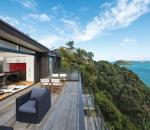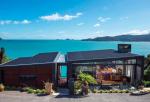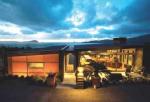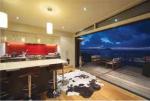Eagle’S Nest
The brief called for a contemporary style, with a rustic Coromandel aspect to accommodate the client’s style. Single level living was required for the couple, with self-contained living below for family. A pole construction design resulted, terracing down the slope and dramatically bisected by a full height entrance and stairwell with views to the gulf. A corten steel façade and stone chimney reference the mining heritage of Coromandel, and continue the organic flavour.
A decaying three level A-Frame bach had been in the family for years. The owners believed the site was too restrictive to redevelop due to its narrow 18 meter width, coupled with the very steep terrain and related daylight angle issues. When they could find no nearby sites to compare, we began looking at the brief and working towards a solution.
The site is on a long thin peninsula and slopes steeply to the north west away from the road down to the rocky shore. Native plants cover the site and surrounding area. Expansive views are enjoyed north over the Hauraki Gulf and islands.
The brief called for a contemporary style, with a rustic Coromandel aspect to accommodate an eclectic mixture of possessions built up over years in the bach. The views were to be as unrestricted as possible as a progression from the earlier narrow A-frame outlook.
Particular challenges of the site included:
- Restrictive day lighting angles combined with the narrowness of the site.
- Dealing with slope in terms of car parking and project build methodology.
- Capturing morning sun due to the building platform nesting below the ridge line road to the east.
- Creating shelter from changeable winds to
- enable outdoor living.
Specific client requests included:
- Bold entrance way.
- Art studio with views.
- View from ensuite bath.
- Large storage area for gardening equipment .
Design Features and Creative Solutions
A two level pole construction was adopted to deal with the slope. The design terraces down the site with the lower floor tucked below the upper level to limit pole lengths and to form the structure for decking above. The cubic forms of the four dwelling components (living, master suite, guest suite and art studio) are dramatically bisected by a full height entrance and stairway. This space leads the eye on a vertical traverse from stairs to vegetated slope, rocky shore, ocean, islands and sky, as a contrasting preview of the more horizontal vistas to follow.
Neighbours were extensively consulted and convinced as to the benefits of mutual consents for daylight encroachments, in maximizing their narrow sites.
This lead to concept design for one neighbour’s home, including images of view implications of each home, before consent was given.
The living pavilion has stacking doors for views, and to extend the site restricted living space each way. South east and north west outdoor areas allow sun and wind flexibility.
Energy efficiency is addressed through solar orientation, sunlight control with eaves to glazing ratio, cross flow ventilation, high level insulation & double glazing.
Internally, rustic timber flooring and a stone chimney offset a neutral palette and invite the owner’s rustic furnishings into the contemporary space.
Externally, dark band sawn weatherboards are used for a natural aesthetic to blend with the bush surrounds. A feature corten steel façade and Coromandel stone chimney reference the mining heritage of the area, and continue the organic flavour of the home.
As the house is set down below the road the aesthetics of the roof were very important. The Trimrib™ lines were chosen to deliberately reflective of the sea swell and chop lines in the Hauraki Gulf beyond & provide continuity with the strong lines of the weatherboard cladding. The ironsand colour was chosen to blend with the native bush setting.
There is a very low pitch central roof axis above the entry/stairs in membrane and the trough profile roof provides a visual contrast to this flat area of roof and creates visual interest with glimpses of the bush and shoreline.





